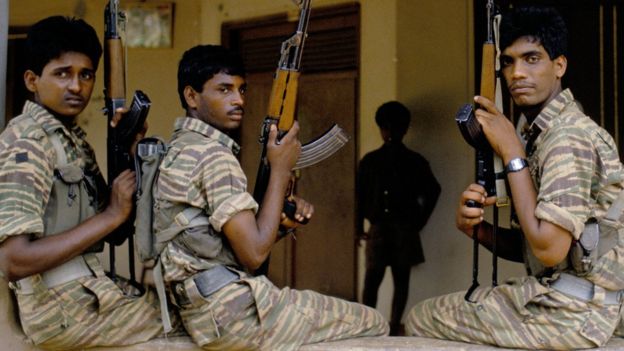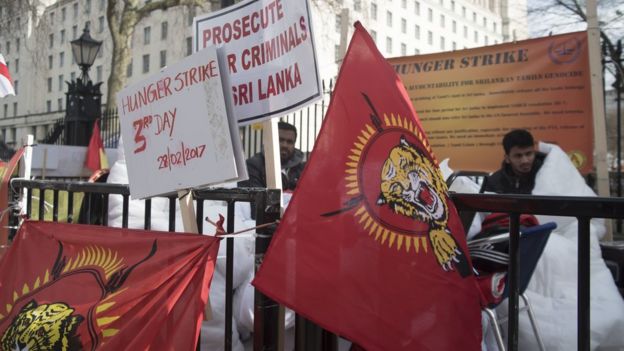The Collective Trauma : Sri Lanka
"Everyone is focusing on building roads, building houses, building hospitals after war. [There is a lack of attention to] the collective trauma."
"Very few people focus on the lives, on helping bring back the happiness. It is not easy."
Dr. V. Jegaruban, Kilinochchi, Sri Lanka
"There is a lack of reliable data to capture the true burden of the mental health, but it's probably much more than the numbers the government is putting out."
"Some of the issues are probably more prevalent in the north and east. But the main disorders -- depression and anxiety -- are across the board."
Nivendra Uduman, psychologist, Sri Lanka
"He always lapses into grief at this time [anniversaries of relatives' deaths in the war]."
"He keeps it all bottled up and denies feeling upset or unhappy. At least we women talk to each other and cry if necessary. He won't do that, ever."
Umadevi Nagendram, Kilinochchi, Sri Lanka
:max_bytes(150000):strip_icc()/london-exiles-protest-sri-lanka-s-treatment-of-tamils-88619226-5b282784ff1b78003727744a.jpg) |
| London Exiles Protest Sri Lanka's Treatment of Tamils. George Rose / Getty Images |
Villagers stream one by one with little blue books representing a personal chronicle of their history of loss dating from the Sri Lankan civil war when government forces struck against the separatist Tamil Tigers rebel militias into Dr. Jegaruban's (known as Dr. Jegan) office. The Kilinochchi district with its 130,000 residents experienced some of the worst fighting between the Tamil Tigers and the Sinhalese majority Sri Lankan Army.
The butchery carried out by both sides in their lethal conflict targeted mostly Tamil civilians, caught between the two armies and used by the Tigers as a living barrier.
According to government estimates about ten percent of Sri Lanka's 22-million population suffer some form of mental disorder; close to 800,000 are held to be suffering from depression. Research, on the other hand, suggests that the government figures represent an under-estimation, particularly in the northern areas of the country where fighting was concentrated. According to studies in the northeast the prevalence of post-traumatic stress disorder among children runs as high as 30 percent.
Among the ten highest suicide rates in the world, Sri Lanka is badly in need of some workable solution to the plight of its traumatized population. Infrastructure improvement for hospital access, restrictions on deadly pesticides convenient for people's use in committing suicide have seen some improvement. However, police continue to register about ten deaths by suicide on a daily basis, while activists estimate the number higher at 15 daily. An additional 100 to 150 people attempt suicide each day.
 |
| Formed in 1976, the Tamil Tigers said they were fighting for a separate state for Tamils in Sri Lanka Getty Images |
Government psychiatrists like Dr. Jegan struggle to meet the demand for treatment from people suffering from this national malaise. More often, however, given the numbers involved, a burden falls upon volunteers in the population coming from all streams of society, from retired bankers, former nurses, local businessmen, trained as counselors who answer calls at suicide hotlines or render assistance with programs such as Dr. Jegan's.
Based in Kilinochchi where some of the worst fighting occurred -- since it was the Tamil Tigers' capital -- the need is greatest there. The brutal offensives against the Tamil Tigers that President Mahinda Rajapaksa embarked upon caught the rebels in Kilinochchi surrounded by the Sri Lankan Army closing the area to international observers where all hell broke loose. Accusations of war crimes by the United Nations went deliberately unnoticed by the government.
The entire population of the area became displaced, with the United Nations claiming some 40,000 civilians were killed as the war wound up. Now, Dr. Jegan goes door to door in the area villages breaking a taboo around mental health that kept many people away from seeking help, to avoid being stigmatized. He handed out little blue books and urged people to record their painful wartime histories.
Typical of such histories, he read aloud to one patient in her 60s sitting quietly before him, her entry: "Husband died of heat attack, one daughter died of war, a sister committed suicide". Committing their grief to paper, allowing the psychiatrist to know their history, hearing their story from his mouth, a communication that may begin a gradual healing process.
When 67-year-old Ulaganathan Nagendram came along with his wife, fearing her husband was in the throes of a heart attack, Dr. Jegan was unable to detect anything physically awry with the man. What was Mr. Nagendram worrying about, he asked the man's wife. The answer: Two sons killed in the war; the anniversary of one of the deaths had just passed.
"The natural disaster [2004 tsunami which killed 31,000 Sri Lankans] was a one-off catastrophic event that left a trail of destruction and loss. But it did not continue to exert a prolonged effect. As a result the severity of the collective trauma was much less. In fact, having lived through a prolonged war situation has meant that Tamil communities have learned skills and strategies that make them better able to cope with disasters."
"Apart from attending to the immediate basic needs and other acute problems in the rescue and relief phases after a major disaster, rehabilitation, reconstruction and development strategies need to include collective-level interventions. In fact, our experiences show that many individually oriented mental health interventions appear to fare much better when undertaken within an overall framework of a community strategy."
Clinical Associate Professor in Psychiatry Daya Somasundaram
 |
| Despite their defeat in 2009, support for the Tamil Tigers is still strong among the Tamil diaspora Getty Images |
Labels: Conflict, Sinhalese, Sri Lanka, Tamil Tigers, Tamils, Trauma

<< Home